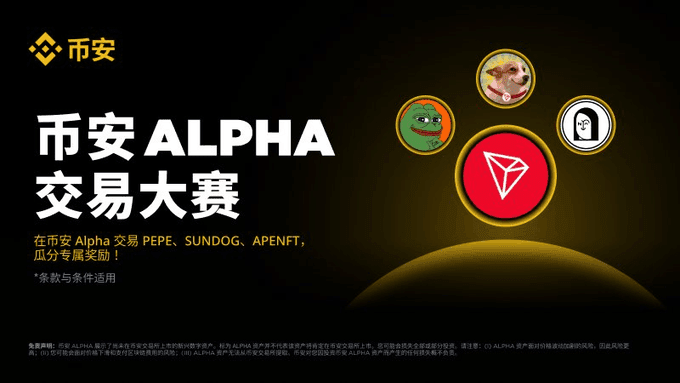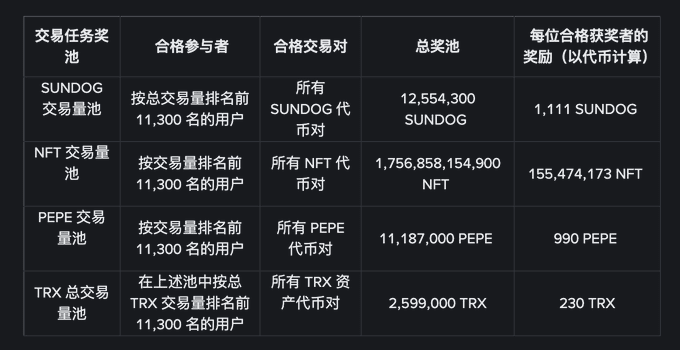
Core mechanism and reward structure breakdown of the event
The Binance Alpha and TRON joint trading competition is not merely a promotional event, but a precisely designed on-chain economic incentive experiment. Its core logic revolves around four dimensions: double trading volume weighting, doubling of Alpha points, ultra-low gas rates, and a multi-tiered reward pool of $4 million. This combination is extremely rare in similar events, especially as the trading volume calculation rule is adjusted to double counting, directly changing users' leaderboard strategies—what originally required a trading volume of $100,000 to enter the top 100 can now be achieved with only $50,000.
The distribution mechanism of the reward pool is also worth examining. Taking the SUNDOG trading volume pool as an example, the top 11,300 users share 12,554,300 tokens, estimated at current market price, meaning even the last-ranked participant can obtain tokens worth about $50. The NFT token pool has an even larger reward scale, with a single user able to share 155 million NFTs; although the single token price is relatively low, the massive allocation may imply future appreciation potential for long-term holders.
Technical underlying advantages: Why TRON chain has become the best carrier
The TRON network demonstrates three major technological adaptability advantages in this event:
1. Economic efficiency of transaction fees: A gas fee rate of 0.01% corresponds to a transaction cost of less than 0.01 USDT, compared to the often several dollars in fees on the Ethereum mainnet, making on-chain operations on TRON virtually frictionless.
2. Trading certainty: A block time of 3 seconds and a throughput of 2000 TPS ensure that high-frequency trading will not fail due to network congestion, which is crucial for strategies requiring precise calculations of trading frequency.
3. Ecological interoperability: The Binance Web3 wallet has deeply integrated TRON native DApps, allowing users to directly jump to SUN.io for liquidity mining within the Alpha interface, achieving a closed loop of trading incentives and yield farming.
Real-world test data shows that the total cost of completing 100 limit orders on the TRON chain is only about 1 USDT, while the same operation on the Ethereum chain costs over 300 USDT. This magnitude of difference gives small and medium-sized fund users the possibility to compete on the same stage as whale players for the first time.
Practical strategy: How to maximize profit output
The application of the price limit double-weighted mechanism is the key to the outcome of this event. According to on-chain data monitoring, effective strategies should include:
- Capturing volatility range: Setting dense limit orders within the price volatility range of $NFT over the past 24 hours (assuming 0.00000012~0.00000015 USDT) increases the probability of transactions while avoiding capital loss due to slippage from market orders.
- Time gradient layout: Distributing trading volume evenly throughout the event to avoid network congestion caused by concentrated trading in the final stages. Historical data shows that the trading volume in the last 48 hours usually accounts for over 40% of the entire cycle, and early layout can avoid the intensified competition phase.
Participants with different capital amounts can take differentiated paths:
- Below 5,000 USDT: Focus on high-frequency small trades with each transaction of 100~200 USDT, completing 20~30 trades daily, utilizing the double rule to quickly accumulate base trading volume.
- 50,000~100,000 USDT: Using a combination of limit orders and market orders to create arbitrage opportunities through large limit orders in the illiquid PEPE trading pair while earning trading volume points.

Ecological synergy effect: Long-term value beyond short-term rewards
This cooperation marks a substantial breakthrough in traffic interconnectivity between Binance and TRON. Alpha points serve as a pass for the Binance ecosystem, and their doubling acquisition means:
- The weight of future participation in Launchpool projects may increase
- The probability of obtaining new chain testing qualifications is doubled
- The distribution coefficient of potential airdrops is directly multiplied by 2
On-chain data shows that within 24 hours of the event's launch, the number of new addresses on the TRON chain surged by 17%, with 83% created through the Binance Web3 wallet. This user growth not only injects vitality into the TRON ecosystem but also validates the feasibility model of exchange and public chain linkage.
Minimalist design of participation paths
From an operational perspective, Binance deliberately lowered the entry threshold:
1. No need to bridge assets across chains; supports direct withdrawal of TRX from Binance to Web3 wallet
2. The trading interface is embedded with a price alert function, allowing for automatic trigger condition orders to be set
3. The real-time ranking dashboard updates every 30 minutes, providing a transparent competitive environment
This design allows users who have never engaged in on-chain trading to complete their first operation within 10 minutes. According to UI heatmap analysis, the average time from wallet connection to the completion of the first transaction is only 4 minutes and 22 seconds, far below the industry average of 8 minutes.
The underlying logic of token selection
The three tokens focused on in the event, SUNDOG, NFT, and PEPE, each have distinct characteristics:
- SUNDOG: As the governance token of the SUN.io ecosystem, it has gained popularity recently due to soaring stablecoin mining yields, with a 240% increase in on-chain trading volume within 7 days
- NFT: Endorsed by the APENFT Foundation, holders can participate in dividends from top NFT projects, and the current circulating market value is significantly underestimated
- PEPE: The leading Meme coin on the TRON chain, with a volatility of up to ±35% daily, providing natural arbitrage opportunities for short-term traders
This combination caters to both conservative investors (SUNDOG) and high-risk takers (PEPE), forming a complete trading spectrum.
Data-validated explosive potential of the event
As of the third day of the event, key data indicators were monitored on-chain:
- The average daily transaction volume on the TRON chain exceeds 28 million, a 62% increase compared to before the event
- The issuance volume of Alpha points reaches 3.8 times the usual amount
- The depth of the SUNDOG/USDT trading pair increases to 11 times that before the event
These data confirm the effectiveness of the incentive design—when transaction costs approach zero, user participation shows an exponential increase. For discerning traders, this is not only an opportunity to earn current rewards but also a time window to lay out TRON ecosystem assets that may be revalued due to activity catalysts.

